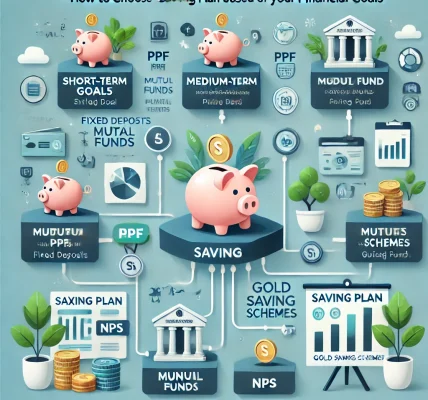Investing your money wisely is one of the most crucial financial decisions you will make in life. As we all strive to secure a comfortable future, choosing the right investment options becomes paramount. Among the popular choices available to investors, Fixed Deposits (FDs) and Saving Plans stand out as two primary options.
But which one is better? Let’s dive deep into the features, benefits, and differences between Fixed Deposits and Saving Plans to help you make an informed decision that aligns with your financial goals.
Understanding Fixed Deposits (FDs)
A Fixed Deposit is a type of investment where you deposit a lump sum amount with a bank or financial institution for a fixed tenure. In return, you earn interest on the amount, which is generally higher than a regular savings account. At the end of the tenure, the principal along with the accrued interest is returned to you.
Key Features of Fixed Deposits:
- Guaranteed Returns: FDs offer a fixed interest rate, ensuring predictable returns.
- Low Risk: Fixed Deposits are one of the safest investment options, as they are usually insured by government schemes (up to a certain limit).
- Flexibility: FDs come with different tenure options, ranging from a few months to several years.
- Taxation: The interest earned is taxable, though there are ways to reduce the tax impact using tax-saving fixed deposits under section 80C of the Income Tax Act.
Pros of Fixed Deposits:
- Safety: Low-risk investment.
- Predictability: Fixed interest rates mean guaranteed returns.
- Liquidity: You can withdraw your FD before the maturity date, though this may incur a penalty.
Cons of Fixed Deposits:
- Inflation Risk: Fixed returns may not keep up with inflation.
- Taxable Interest: Interest is taxed as per your income tax slab.
- No flexibility in changing investment amount: Once you commit to the FD amount, it stays fixed.
Understanding Saving Plans
A Saving Plan typically refers to a structured approach to saving money, which could be a variety of savings tools offered by banks, insurance companies, or financial institutions. These plans often encourage you to save a fixed amount regularly (monthly or annually) to accumulate a sum over time.
Key Features of Saving Plans:
- Regular Contributions: Unlike FDs, savings plans usually involve regular contributions over a specified period.
- Variety of Options: These plans can include insurance-linked savings schemes, post-office savings plans, government-backed schemes like PPF (Public Provident Fund), or even recurring deposit plans offered by banks.
- Goal-Oriented: Many saving plans are designed with specific goals in mind, such as retirement savings or education funding.
- Interest Rates: The returns may be fixed or variable depending on the type of saving plan chosen.
Pros of Saving Plans:
- Discipline: Regular savings build a habit of disciplined investing.
- Tax Benefits: Some saving plans offer tax benefits under section 80C (such as PPF, NSC, etc.).
- Flexibility: You can adjust the contribution amount based on your financial capacity.
Cons of Saving Plans:
- Returns May Vary: In some plans (e.g., linked to market returns), the returns may not be fixed.
- Lock-in Period: Some saving plans come with a lock-in period, especially those with tax benefits.
- Limited Liquidity: Some saving plans do not allow easy access to funds before maturity.
Fixed Deposits vs. Saving Plans: A Comparison
| Criteria | Fixed Deposits | Saving Plans |
|---|---|---|
| Risk | Low risk | Varies (can be low to medium depending on the plan) |
| Returns | Fixed, guaranteed returns | Can be fixed or variable, depending on the plan |
| Liquidity | Can be withdrawn early (with penalty) | Varies; some plans have lock-in periods |
| Taxation | Interest is taxable | Some plans offer tax benefits under section 80C |
| Investment Flexibility | Fixed lump sum, no changes | Regular contributions, adjustable as per capacity |
| Purpose | Short-term to medium-term savings | Long-term goal-based savings |
| Suitability | Ideal for low-risk investors seeking guaranteed returns | Ideal for disciplined savings towards a goal over time |
Which One is Better for You?
Choosing between Fixed Deposits and Saving Plans depends on your financial goals, risk tolerance, and time horizon.
- Choose Fixed Deposits if:
- You are looking for a low-risk, short-term investment option with guaranteed returns.
- You prefer a lump sum investment and want to avoid market-related risks.
- You need a fixed income stream and can commit to the amount for the term of the FD.
- Choose Saving Plans if:
- You want to save for long-term goals like retirement, education, or buying a house.
- You prefer flexibility and discipline in saving regularly.
- You are okay with moderate risk and are looking for tax-saving benefits.
Conclusion
Both Fixed Deposits and Saving Plans have their advantages, depending on your financial goals and risk appetite. Fixed Deposits are ideal for those seeking stability and guaranteed returns, whereas Saving Plans work best for those looking to build a financial corpus over time with regular contributions.




